5 Key Fleet Management Software Features and Top Products That Offer Them
Fleet managers oversee business cars, trucks, and other types of motorized fleets—you name it and their days are packed with keeping them all running smoothly while simultaneously ensuring driver safety. A fleet management solution can help businesses better track all of their vehicles in real time, find the most efficient routes for drivers, and even save fuel costs in the process.
However, there are multiple fleet management systems available on the market. Learning about the software’s key features can provide you with the information you need to find the right tool based on your specific processes and requirements.
To help you choose, this article highlights five key fleet management software features based on the ratings given by verified software users. We also include the highest-rated fleet management software solutions for each feature. Read more.
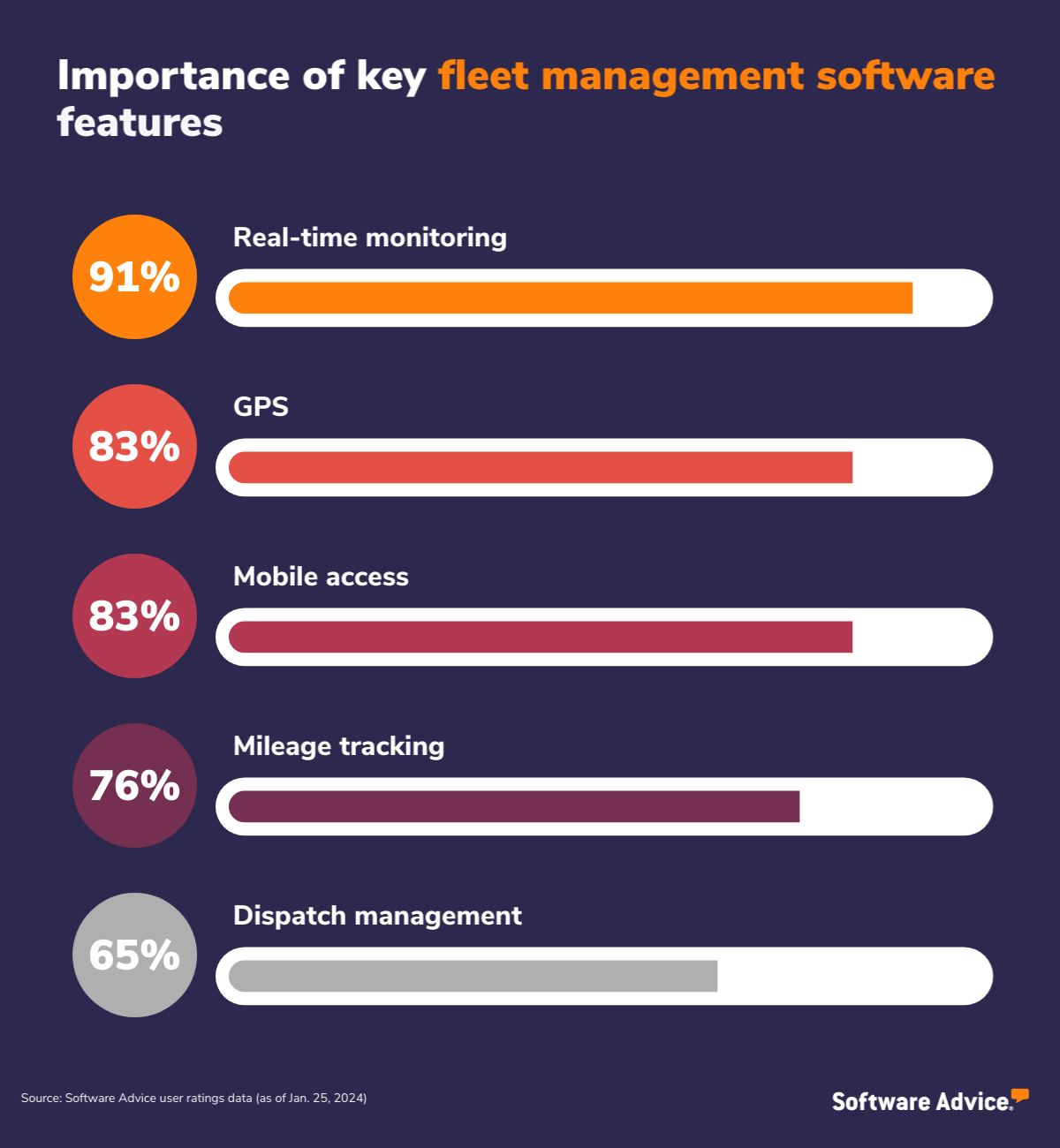
1. Real-time monitoring
Real-time monitoring in fleet management software allows a fleet manager to track and manage vehicles, assets, or personnel, as they move and operate. The feature offers instant updates to users on various aspects of the fleet, including vehicle location, routes taken by the vehicles, and fuel consumption. Users can monitor driver behavior, including harsh accelerations and distracted driving to promote safe driving practices and minimize the risk of accidents.
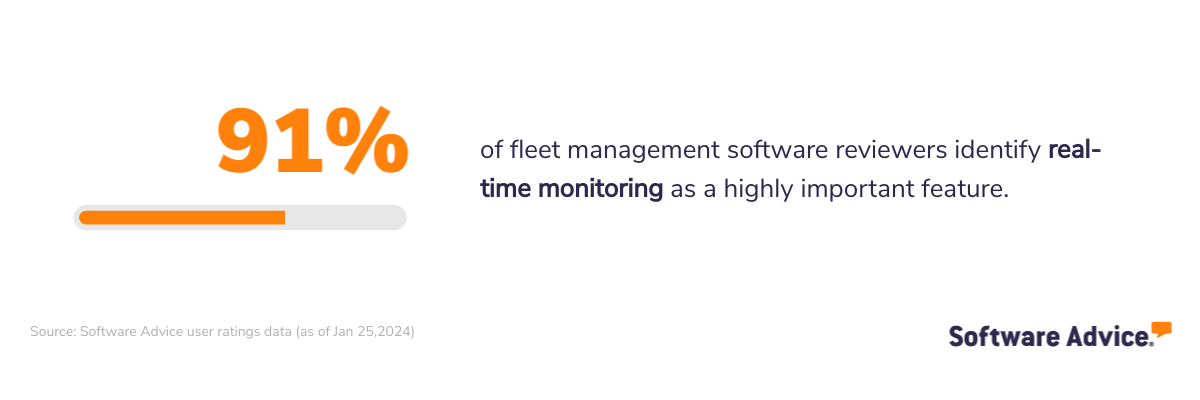
What business problem does real-time monitoring solve?
Relying on manual methods such as driver reports and phone calls for tracking vehicle location and status can be time-consuming and prone to errors. Moreover, the absence of real-time data can impact the efficiency of business due to delays in addressing issues such as inefficient routes and driver behavior concerns. Real-time monitoring helps a fleet manager optimize their operations and track vehicles in real time to choose the best routes depending on traffic, weather, and other conditions.
Ideal users of the real-time monitoring feature
Fleet managers across transportation and logistics businesses can leverage real-time monitoring to optimize routes, track shipments, and ensure timely deliveries. Additionally, delivery services can also use this feature to track delivery vehicles and provide accurate delivery times to customers, enhancing the overall customer experience and satisfaction.
Top 3 products with the highest ratings for real-time monitoring
Analysis performed January 2024*
Real-time monitoring feature rating: 4.87/5
Real-time monitoring feature rating: 4.84/5
Real-time monitoring feature rating: 4.56/5
2. Mobile access
The mobile access feature allows users to access and manage fleet-related information using their mobile devices, such as tablets and smartphones, enhancing visibility into a fleet operation. It enables users to receive instant alerts and notifications on their devices for critical events, such as fleet maintenance reminders and high-speed alerts. Fleet management solution with mobile access offers instant access to dashboards, enabling users to adjust routes, obtain performance insights, and respond to critical events even on the go.
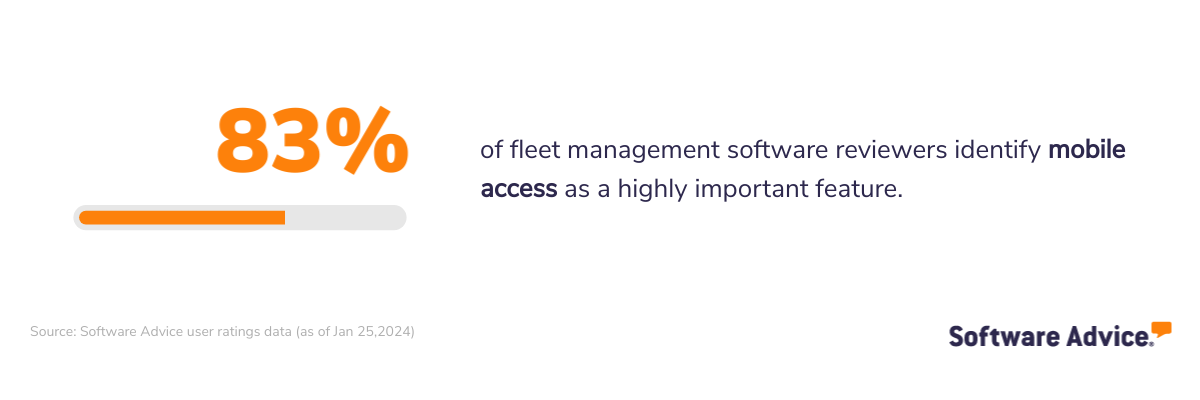
What business problem does mobile access solve?
Timely communication with drivers is important for assigning tasks and addressing issues on the fly. However, fleet management businesses often face delayed communication, which can lead to missed deliveries, wasted resources, and frustrated customers. Mobile access enables two-way messaging, allowing instant exchange of information and updates. Users can access driver location, status, and vehicle progress in real time, enabling timely communication and adjustments.
Ideal users of the mobile access feature
Supervisors and dispatchers across fleet management businesses can use the mobile access feature to manage fleet activities in real time, make quick decisions, and address issues promptly. The feature can also benefit business owners in staying informed about fleet performance, costs, and overall efficiency, even when not in the office.
Top 3 products with the highest ratings for mobile access
Analysis performed January 2024*
Mobile access feature rating: 4.92/5
Mobile access feature rating: 4.86/5
Mobile access feature rating: 4.81/5
3. Global Positioning System (GPS)
Global Positioning System feature allows fleet managers to track the real-time location of vehicles within a fleet, which is displayed on a digital map interface within the software. Fleet managers can use this data to optimize routes for drivers, helping them select the most efficient paths to their destinations. GPS data can also be used to identify patterns, trends, and areas of improvement in routing, scheduling, and resource allocation.

What business problem does GPS solve?
Fleet assets are constantly on the move, making it manually difficult to maintain accurate information about their locations and statutes. Moreover, these are susceptible to theft, unauthorized use, and misuse. GPS enables fleet managers to monitor the real time location of vehicles as they move through various routes and regions. This helps them respond to emergency situations and minimize disruptions if any. Users can also leverage this feature to detect unauthorized movement and deviation from planned routes.
Ideal users of the GPS feature
Fleet management professionals involved in transporting goods and materials can use this feature to monitor vehicles and ensure timely deliveries. Additionally, fleet managers across construction and equipment rental businesses can also leverage this feature to track the exact location and usage of heavy equipment, such as cranes and excavators, ensuring optimal asset utilization and theft prevention.
Top 3 products with the highest ratings for GPS
Analysis performed January 2024*
GPS feature rating: 4.94/5
GPS feature rating: 4.90/5
GPS feature rating: 4.74/5
4. Mileage tracking
Mileage tracking in fleet management systems allows users to monitor and record the distance traveled by vehicles in their fleet. The feature tracks how far has the vehicle traveled over a certain period of time, aiding in fuel cost analysis, vehicle maintenance scheduling, and compliance reporting. Fleet managers can use this feature to record details, such as start and end points for vehicles, total distance traveled, fuel consumption, and any associated expenses.
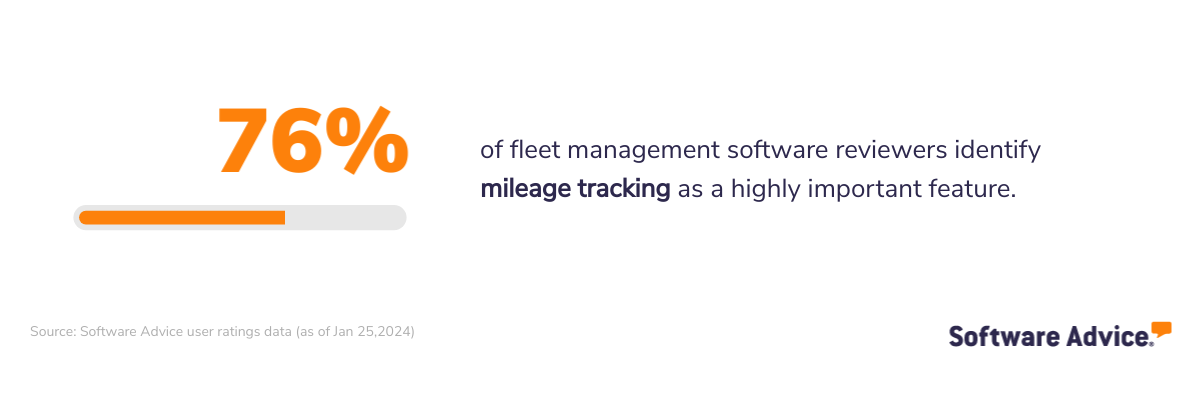
What business problem does mileage tracking solve?
Fleet managers often need to find ways to optimize fuel usage and improve fuel efficiency. Mileage tracking feature in the fleet management system enables fleet managers to monitor fuel consumption and identify inefficient drivers and routes. This data can be used to implement fuel-saving strategies. Additionally, the feature can be used to trigger preventive fleet maintenance based on actual vehicle usage, which can prevent unexpected vehicle breakdowns.
Ideal users of the mileage tracking feature
Fleet managers looking to overcome cost management challenges can benefit the most from the mileage tracking feature in fleet management software. Users can leverage this feature to gain data-driven insights that can further help them reduce fuel costs, optimize vehicle maintenance schedules, promote better driver behavior, and make informed decisions about vehicle replacement.
Top 3 products with the highest ratings for mileage tracking
Analysis performed January 2024*
Mileage tracking feature rating: 4.89/5
Mileage tracking feature rating: 4.81/5
Mileage tracking feature rating: 4.70/5
5. Dispatch management
Dispatch management enables efficient coordination and assignment of tasks, vehicles, and drivers in a fleet operation. The feature allows fleet management professionals to assign tasks, such as deliveries and pickups to specific drivers based on their availability, skillset, and other criteria. It also facilitates communication between dispatchers and drivers, allowing them to exchange messages, updates, and instructions.
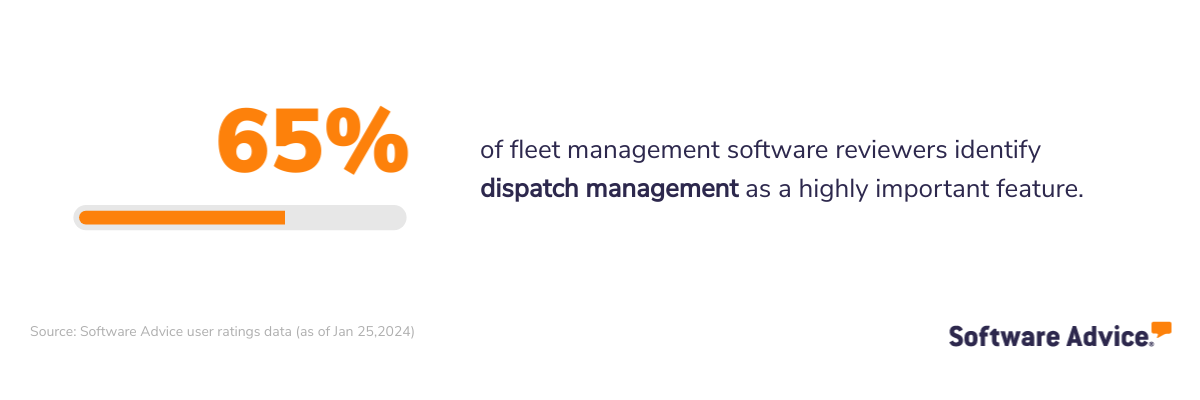
What business problem does dispatch management solve?
Dispatch management helps with resource optimization by ensuring that vehicles and drivers are allocated effectively. This optimization minimizes idle time for vehicles and maximizes the utilization of fleet resources, ultimately leading to fuel cost savings and improved productivity. The process automates task assignment and communication processes to help fleet businesses reduce manual errors, minimize delays, and improve overall operational efficiency.
Ideal users of the dispatch management feature
Delivery service managers looking to assign workload and communicate with drivers to ensure timely deliveries can benefit the most from the dispatch management feature. Additionally, logistics coordinators managing the movement of goods and materials within the supply chain process can also use this feature to coordinate deliveries, set up automated dispatch rules, optimize resource allocation, and increase visibility over the entire logistics chain.
Top 3 products with the highest ratings for dispatch management
Analysis performed January 2024*
Dispatch management feature rating: 4.85/5
Dispatch management feature rating: 4.35/5
Dispatch management feature rating: 4.05/5
Methodology
Key features: To identify the key features of this article, we asked users to rate, on a scale of “low importance” to “critical,” how important different features are for fleet management software. The features showcased are those that the highest percentage of reviewers rated as “highly important” or “critical” over the past two years (as of Jan. 25, 2024).
Feature eligibility: To be included in the set of features considered, a given feature had to have at least 200 user ratings within the past two years (as of Jan. 25, 2024), of which at least 20% must indicate the feature is “critical.” Eligible features were determined from two sources:
Our research team’s review of public information about fleet management software usage, definitions, and associated features.
Reviewers’ indication of the features they use for fleet management feedback.
Product selection: To identify the top-rated products per feature, we evaluated user ratings for products that offer each feature. For a given product, reviewers rate each feature on a scale of one to five stars. A given product had to have at least 20 user ratings (between January 2022-24) for the feature in question to be considered.
*We selected products for this article based on their average ratings between January 2022 - January 2024, which may differ from their current overall average ratings.